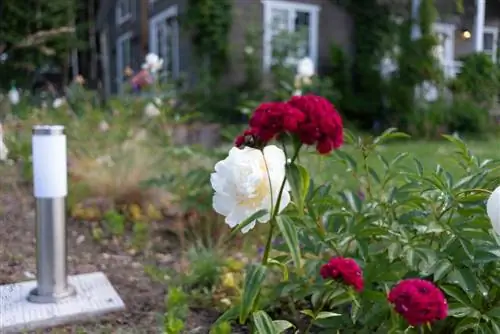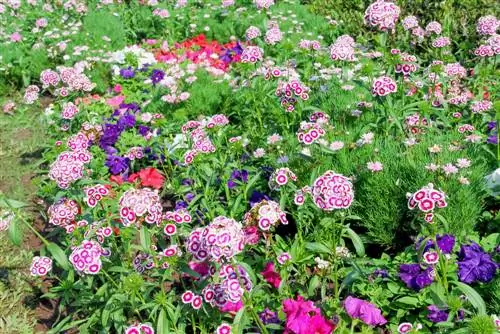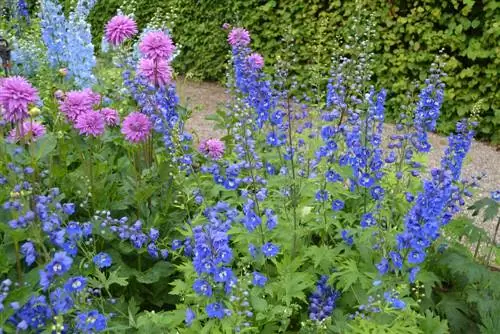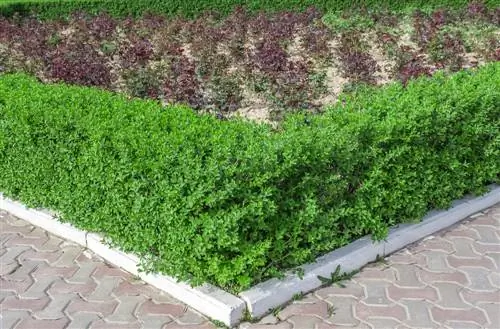- Author admin [email protected].
- Public 2023-12-16 16:46.
- Last modified 2025-01-23 11:22.
Within a short time, carnations form cushions and shower us with their numerous and often multi-colored flowers. Below you will find out how you can highlight these wonderfully fragrant plants in the garden and on the balcony in conjunction with other plants.

Which plants can I combine with carnations?
Carnations harmonize particularly well with daisies, lavender, bluebells, foxgloves, hollyhocks, peonies, gypsophila and sedum, as they have similar location requirements and flowering times. Especially with similar or contrasting colors, an attractive picture is created in the garden or in the vase.
What factors should you consider when combining cloves?
To successfully showcase the face of carnations in combination with companion plants, you should consider these factors:
- Flower color: white, apricot, pink or red
- Flowering time: June to September
- Site requirements: sunny, loose and poor soil
- Growth height: up to 40 cm
Carnations get along well with plants that also prefer loose and poor soil. Therefore, consider the location requirements of the carnations in your planning.
Taking into account the height of growth when making combinations is extremely useful. But be careful: Depending on the type of carnations, they tend to grow low and form cushions or become slightly larger.
It is recommended to surround carnations with companion plants that are in bloom at about the same time as them. So you can create a heart-conquering sea of flowers.
Combine carnations in the bed or in the pot
Carnations can really come to life in the foreground of beds. There they unfold their true beauty and, planted in small tuffs, cover the entire ground. Plant neighbors that have similar flowers and whose color contrasts with the carnations are wonderful. Behind the carnations, however, there can be taller growing perennials. Those that have larger or at least differently shaped flowers, such as daisies, are ideal.
Perfect companion plants for carnations include:
- Daisies
- Lavender
- Bluebells
- Foxglove
- Hollyhocks
- Peonies
- Cushion's Gypsophila
- Sedum
Combine carnations with peonies
Since most carnations bloom in June, they are suitable for peonies, which also bloom in early/mid-June. For example, the carnation 'Pink Kisses' is wonderfully suited to interacting with a pink to pink-flowering peony. However, the carnation should be placed in front of the peony because it is much smaller.
Combine carnations with daisies
Both carnations and daisies like sunny locations on poor and well-drained soil. But these two harmonize not only in terms of location. The white-yellow daisies with their long stems rise slightly above the carnations. The carnations benefit visually from the whiteness of the daisies and red, pink or pink varieties in particular appear impressive in the combination.
Combine cloves with gypsophila
The cushion's gypsophila is vaguely reminiscent of cloves. The two look alike and love to stand in the sun and surprise us with a preponderance of delicate flowers. If you like it romantic, combine pink carnations with white gypsophila.
Combine carnations as a bouquet in the vase
It's not without reason that carnations are one of the most popular cut flowers. Their appearance looks even more sensual in a vase in combination with other flowers. Roses, for example, go wonderfully with them and you can drape them with carnations in similar colors. Color contrasts, however, are created with ornamental garlic and hydrangeas.
- Roses
- hydrangeas
- Gypsophila
- Chrysanthemums
- Gerbera
- Daisies
- ornamental onion
- Lilies






